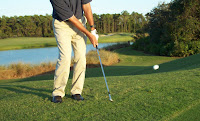Sunday, November 29, 2009
Bunker Lesson - Splash the Sand out to get the Ball out!
But, since it's the sand that lifts the ball out of the bunker (see: Don't Scramble Your Egg!), then it makes sense that the sand has to travel far enough to get the ball to go far enough as well.
Watch this short 2-minute video to see how it's done!
Saturday, November 28, 2009
Getting out of a Bunker - "Don't Scramble Your Egg!"
Friday, November 20, 2009
Trouble With Chip Shots? Finish Low... Ball Goes Up!
To get students to consistently hit good chip shots, I have them focus on their finish position. Oftentimes, students try to “lift” the ball (known as “scooping”) into the air… when in fact, the opposite holds true. The job of the golfer should be to deliver the club down to the ball and let the loft of the club lift the ball up in the air.
Scooping leads to hitting the ground prior to the ball… causing the ball to travel a very short distance AND/OR hitting the top of the ball or on its equator… sending the ball screeching across the green, oftentimes off the green on the opposite side.
If this describes the shots you typically experience when chipping… then try the following:
1. Set up with feet about eight to 12 inches apart.
2. Set up closer to the ball than you normally would set up for a full shot.
3. Lean toward your forward foot (foot closest to the target) and keep the weight on that foot throughout the entire shot (should feel that about 60% of your weight is on your forward foot).
4. Bring the club back using your shoulders and very little wrist hinge.
5. Stroke through and past the ball and FINISH VERY LOW TO THE GROUND WITH THE CLUBHEAD (see illustration above).
The stroke itself is not that uncommon to the putting stroke. If you finish low… the ball should pop up into the air, land softly and roll. Never try to "lift" the ball into the air.
Good Golfing to YOU!
Thursday, November 19, 2009
Establishing Good Practice Techniques

As a golf instructor, it amazes me how little focus most people have when they practice. I often see individuals drag a second ball to hit before their previous shot has even finished landing! Even during lessons, sometimes I’ll watch a student’s ball to determine flight, curvature, reaction on the ground, etc… and when I turn my attention back to the student, he or she already has another ball in place… ready to hit!
If you’re serious about getting better, you must… (YOU MUST redux) practice effectively, with purpose, and with patience… more than perhaps anyone else on the practice range. Here are some things to look for (from right-handed golfer’s perspective) when practicing:
- Watch the direction that the ball starts. Did it start straight, left, or right of your intended target? Observing the direction the ball starts oftentimes indicates your swing path’s approach to the ball. Too far inside… and the ball may start to the right of the target line. Too far from the outside and the ball will start left of the target line. And of course… there’s the importance of alignment. Many students think they hit balls off target because of poor swing mechanics, only to realize after I show them, that they’re aimed wrong to begin with.
- Watch to see what direction the ball curves. Curvature of the ball indicates what the clubface was like at impact. Slices and fades indicate an open clubface, hooks and draws… closed clubface. Excessive curvature may indicate a faulty grip position.
- Watch to see the trajectory of the ball. Too high may indicate scooping rather than hitting down and compressing the ball or little or no forward weight transfer during impact. A ball flight that is too low may indicate sliding ahead of the ball during impact position or coming down on the ball too steep.
- Watch to see the ball land. How else are you going to know how far you consistently hit it? Also, does the ball stop… spin back… release… other?
In addition to monitoring ball reaction, focus on going through the same pre-shot routine with every shot… just as you should be doing on the golf course. You do, do that on the golf course… don’t you? Pre-shot routines develop consistency as well as keep your nerves in check when playing that 25 cent skins game on Saturdays.
So practice with purpose. Take enough time between each shot to observe outcome AND if need be… make appropriate corrections.
Heck, at the very least… slowing down will save you money by making one range basket last an hour instead of going through three of them in the same amount of time. There… I just gave you some financial advice as well!
Good Golfing To You!

